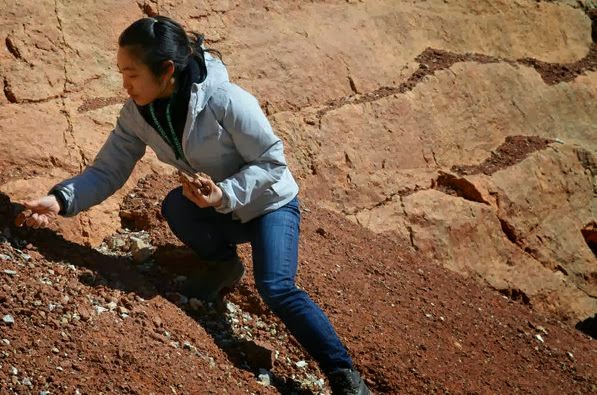
Tourists flock to Italy to see Michelangelo’s David and other iconic hunks of Renaissance stone, but in a trip over spring break, a group of Columbia students got to visit rocks that have shaped the world in even more profound ways. In the limestone outcrops of Italy’s Apennine Mountains, geologist Walter Alvarez collected some of the earliest evidence that a massive fireball falling from space some 66 million years ago was responsible for killing off the dinosaurs. Geologists have trekked to the region since then to study that catastrophic event as well as others imprinted in these rocks.
In March, it was the Columbia students’ turn. Led by Steven Goldstein and Sidney Hemming, scientists at Columbia’s Lamont-Doherty Earth Observatory, and visiting scientist David Barbeau, the students touched evidence of undersea mudslides, the drying of the Mediterranean Sea, and several extinction crises, including the one that ended the Age of Dinosaurs.
From about 200 million years ago to 6 million years ago, the vast, shallow Tethys Sea covered much of the Apennines, in Italy’s Umbria-Marche region. As the tiny plants and animals that lived in the sea died, their shells and skeletons piled up, leaving a record of the environment in which they lived. Later, tectonic forces rearranged this landscape, forming the Apennines in several bouts of squeezing and stretching. The activity left limestones made up of tiny microfossils exposed on land, providing a page-by-page story of the past.
More than any other geologist, Alvarez and his late father, Luis, are responsible for putting these rocks on the map. Now a professor-emeritus at University of California, Berkeley, the younger Alvarez began his career at Lamont-Doherty Earth Observatory in the late 1960s at the height of the plate tectonic revolution. In the 1970s, Alvarez traveled to the Bottaccione Gorge in Gubbio to measure magnetic reversals recorded in the rock to understand how seafloor spreading had moved Earth’s continents. Earth’s magnetic field periodically flips, leaving invisible stripes on the seafloor where magma rising from the mantle is magnetized in a northerly or southerly direction. These stripes also showed up in the Apennines, and Alvarez hoped that by dating them using the microfossils in each layer, he could learn more about the movement of continents.
But he stumbled across another mystery. At about 66 million years ago, the one-celled Globotruncana foraminifera suddenly disappeared from the fossil record, replaced by a smaller, more opportunistic species. Separating the two species was a half-inch of mud with no life at all. Testing the clay, Alvarez discovered high levels of the rare element iridium-an element rare on Earth’s surface but common in space. In a 1980 paper in Science, Alvarez hypothesized that a large comet or asteroid had fallen to Earth, kicking up a dust layer that blocked out the sun, starving much of life on earth. The dinosaurs and more than half of Earth’s species died during this time, marking the end of the Cretaceous period and start of the Tertiary, or in geology jargon: the K/T, boundary. In the late 1970s, two geophysicists searching for oil off Mexico’s Yucatán Peninsula discovered a 110-mile wide crater but it was many years before the Chicxulub crater was conclusively linked to Alvarez’s theory.
Sandro Montanari met Alvarez on one of his field trips to Gubbio, and at Alvarez’s encouragement, flew to California to pursue a PhD in geology. Among other things, Montanari collected evidence for a mega-tsunami in the Gulf of Mexico triggered by a six-mile wide asteroid crashing into the Yucatán. Eventually, Montanari returned to Italy and with Alvarez, bought and restored a farming hamlet, Coldigioco, outside the town of Apiro. Since 1992, Coldigioco has served as a base camp for geologists working in the area. Barbeau spent a summer there as a student at Carleton College, so when his colleagues at Lamont were searching for a new place to take students on spring break, Barbeau suggested the Apennines.
In the weeks leading up to the trip, the students read scientific papers detailing the discoveries made in this region and took turns presenting the material in class. They covered Italy’s tectonics and the evidence for several mass extinctions recorded in the Apennines’ exposed marine sediments of the Apennines—the K/T extinctions 66 million years ago; the Paleocene-Eocene Thermal Maximum, about 55 million years ago, when a rapid warming of the planet killed off many species, leading to the rise of some modern mammals; and the Eocene-Oligocene extinctions, about 34 million years ago, marked by a rapid cooling and the emergence of ice on Antarctica.
They would also study the drying of the Mediterranean Sea in an event called the Messinian Salinity Crisis, about 6 million years ago, and how scientists, including Lamont’s William Ryan, pieced the story together from sediments collected at sea; and the formation of the Frasassi Caves, discovered by their guide, Montanari, as a teenager. One day after their plane landed in Milan, they were on the ground, seeing, tasting and touching the places they had read about.
Video :
The above story is based on materials provided by Columbia University










